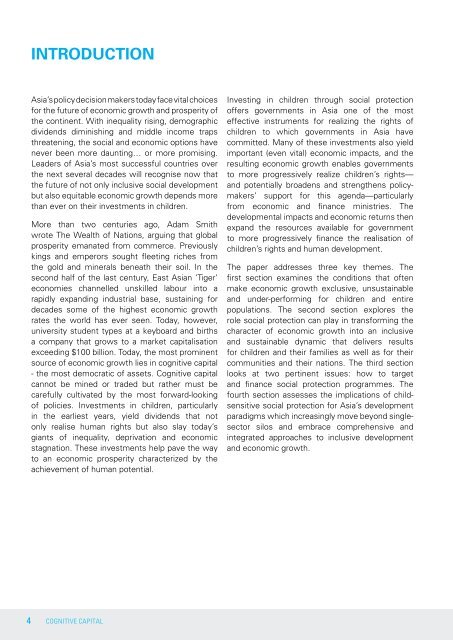COGNITIVE CAPITAL
2ehh0jH
2ehh0jH
Create successful ePaper yourself
Turn your PDF publications into a flip-book with our unique Google optimized e-Paper software.
INTRODUCTION<br />
Asia’s policy decision makers today face vital choices<br />
for the future of economic growth and prosperity of<br />
the continent. With inequality rising, demographic<br />
dividends diminishing and middle income traps<br />
threatening, the social and economic options have<br />
never been more daunting… or more promising.<br />
Leaders of Asia’s most successful countries over<br />
the next several decades will recognise now that<br />
the future of not only inclusive social development<br />
but also equitable economic growth depends more<br />
than ever on their investments in children.<br />
More than two centuries ago, Adam Smith<br />
wrote The Wealth of Nations, arguing that global<br />
prosperity emanated from commerce. Previously<br />
kings and emperors sought fleeting riches from<br />
the gold and minerals beneath their soil. In the<br />
second half of the last century, East Asian ‘Tiger’<br />
economies channelled unskilled labour into a<br />
rapidly expanding industrial base, sustaining for<br />
decades some of the highest economic growth<br />
rates the world has ever seen. Today, however,<br />
university student types at a keyboard and births<br />
a company that grows to a market capitalisation<br />
exceeding $100 billion. Today, the most prominent<br />
source of economic growth lies in cognitive capital<br />
- the most democratic of assets. Cognitive capital<br />
cannot be mined or traded but rather must be<br />
carefully cultivated by the most forward-looking<br />
of policies. Investments in children, particularly<br />
in the earliest years, yield dividends that not<br />
only realise human rights but also slay today’s<br />
giants of inequality, deprivation and economic<br />
stagnation. These investments help pave the way<br />
to an economic prosperity characterized by the<br />
achievement of human potential.<br />
Investing in children through social protection<br />
offers governments in Asia one of the most<br />
effective instruments for realizing the rights of<br />
children to which governments in Asia have<br />
committed. Many of these investments also yield<br />
important (even vital) economic impacts, and the<br />
resulting economic growth enables governments<br />
to more progressively realize children’s rights—<br />
and potentially broadens and strengthens policymakers’<br />
support for this agenda—particularly<br />
from economic and finance ministries. The<br />
developmental impacts and economic returns then<br />
expand the resources available for government<br />
to more progressively finance the realisation of<br />
children’s rights and human development.<br />
The paper addresses three key themes. The<br />
first section examines the conditions that often<br />
make economic growth exclusive, unsustainable<br />
and under-performing for children and entire<br />
populations. The second section explores the<br />
role social protection can play in transforming the<br />
character of economic growth into an inclusive<br />
and sustainable dynamic that delivers results<br />
for children and their families as well as for their<br />
communities and their nations. The third section<br />
looks at two pertinent issues: how to target<br />
and finance social protection programmes. The<br />
fourth section assesses the implications of childsensitive<br />
social protection for Asia’s development<br />
paradigms which increasingly move beyond singlesector<br />
silos and embrace comprehensive and<br />
integrated approaches to inclusive development<br />
and economic growth.<br />
4 <strong>COGNITIVE</strong> <strong>CAPITAL</strong>


